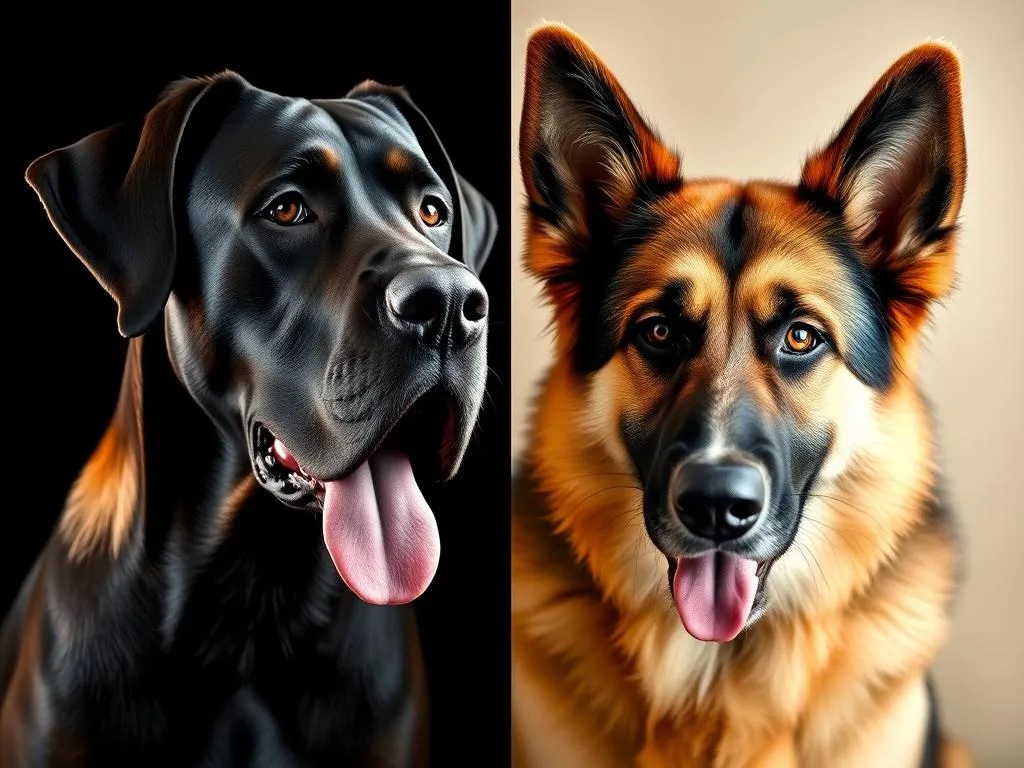
Dog breeds have captivated the hearts of many, each offering unique traits and characteristics that appeal to different types of owners. Choosing the right breed is crucial, especially for potential dog owners who want a companion that fits their lifestyle. Two of the most beloved breeds in the canine world are the Great Dane and the German Shepherd. Both breeds have rich histories, distinctive physical traits, and unique temperaments. This article will delve into the details of these two breeds, providing a comprehensive comparison to help you decide which might be the best fit for your home.
Overview of Dog Breeds
Definition of Dog Breeds
A dog breed is a specific group of domesticated dogs that have been selectively bred for certain traits, behaviors, and physical characteristics. Each breed possesses unique qualities that can influence their adaptability to various living situations, their temperament, and their compatibility with different families. Understanding these breed characteristics is essential in making an informed decision when selecting a dog.
Factors to Consider When Choosing a Dog Breed
When choosing a dog breed, consider the following factors:
– Lifestyle Compatibility: Assess how much time you can dedicate to a dog, considering work commitments and social activities.
– Space Requirements: Evaluate your living situation. Larger breeds like the Great Dane may need more space compared to a German Shepherd.
– Activity Level: Different breeds have varying energy levels; some may require more exercise than others.
– Family Dynamics: Consider how the dog will fit into your family structure, especially if you have children or other pets.
Great Dane: The Gentle Giant
Historical Background
The Great Dane has a fascinating history that traces back to ancient times. Originally bred in Germany, these dogs were developed from a mix of the Mastiff and Greyhound breeds. They were primarily used for hunting large game, such as wild boar, and later became known as guardians due to their imposing size. Over time, their reputation shifted, and they became beloved family companions, often referred to as “gentle giants.”
Physical Characteristics
The Great Dane is renowned for its impressive stature, with males typically standing between 30 to 34 inches tall and weighing between 140 to 175 pounds. Their coat comes in various colors, including fawn, brindle, blue, black, and harlequin patterns. They have long, elegant necks, deep chests, and distinctive floppy ears that can be cropped or left natural.
Temperament and Behavior
Known for their friendly and affectionate nature, Great Danes are often good with children and other pets. They are generally calm and gentle, making them excellent family dogs. However, due to their size, training and socialization from an early age are critical to ensure they develop into well-mannered adults. Common behavioral issues can include separation anxiety and stubbornness if not trained consistently.
Health Considerations
While Great Danes are generally healthy, they are prone to certain health issues, such as bloat (gastric torsion), hip dysplasia, and heart problems. Their lifespan averages between 7 to 10 years, so regular veterinary check-ups and a balanced diet are essential for maintaining their health.
German Shepherd: The Versatile Protector
Historical Background
The German Shepherd is a breed that originated in Germany in the late 19th century. Developed as a herding dog, they were bred for their intelligence, strength, and versatility. Their skills have made them favorites in various roles, including police work, military service, and as service dogs for individuals with disabilities.
Physical Characteristics
German Shepherds are medium to large-sized dogs, typically standing between 22 to 26 inches tall and weighing between 50 to 90 pounds. They have a dense double coat, which can be short or long, and comes in various colors, including black and tan, sable, and all-black varieties. Their distinctive features include upright ears and a strong, athletic build.
Temperament and Behavior
German Shepherds are known for their loyalty, intelligence, and versatility. They are highly trainable and excel in obedience, making them suitable for various tasks and roles. They are typically protective of their families and can be wary of strangers. Early socialization and consistent training are crucial, as they can develop behavioral issues such as aggression or anxiety if not properly managed.
Health Considerations
Common health issues in German Shepherds include hip and elbow dysplasia, degenerative myelopathy, and certain heart conditions. Their lifespan ranges from 9 to 13 years. Regular exercise, a healthy diet, and routine vet visits can help mitigate some of these health risks.
Great Dane vs German Shepherd: A Comparative Analysis
Size and Space Requirements
When comparing size and space requirements, Great Danes are significantly larger than German Shepherds. While a Great Dane may require a spacious home with a yard to accommodate their size, German Shepherds are more adaptable and can thrive in various living situations, including apartments, provided they receive enough exercise.
Exercise and Activity Level
Both breeds require regular exercise, but their needs differ. Great Danes enjoy moderate exercise, such as daily walks and playtime but are generally more relaxed. In contrast, German Shepherds are high-energy dogs that require more vigorous activities, such as running, agility training, and interactive play. Ideally, a German Shepherd owner should be prepared for at least 1-2 hours of exercise daily.
Grooming and Maintenance
In terms of grooming, Great Danes have relatively low grooming needs due to their short coat, requiring minimal brushing. However, they do shed, and regular cleaning is necessary. German Shepherds, with their double coat, shed more heavily and require more frequent brushing, especially during shedding seasons. Both breeds benefit from regular baths and nail trimming.
Training and Socialization
Training and socialization are essential for both breeds, though they present unique challenges. Great Danes may be stubborn and require patient training methods. German Shepherds, being highly intelligent, often respond well to training but can become bored if not challenged. Early socialization is vital for both breeds to prevent behavioral issues.
Family Compatibility
Both breeds can be excellent family dogs, but their compatibility can vary based on family dynamics. Great Danes are generally gentle with children and can be protective, while German Shepherds are loyal and can be very protective of their families. Both breeds can adapt well to homes with other pets, but early socialization is crucial for ensuring harmonious relationships.
Cost of Ownership
The cost of owning a dog varies significantly based on breed. The initial purchase price or adoption fees for Great Danes can range from $1,000 to $3,000, while German Shepherds typically fall within the same range. Ongoing costs, including food, grooming, and veterinary care, can also be substantial, particularly for larger breeds. On average, owners should budget for $1,000 to $1,500 annually for routine care.
Personal Stories and Testimonials
Great Dane Owners’ Experiences
Many Great Dane owners describe their dogs as gentle giants with loving dispositions. A common sentiment is their surprising agility and playfulness despite their size. Owners often share anecdotes of their Great Danes being incredibly patient with children and even other animals. However, some challenges include managing their size in public spaces and ensuring they receive enough exercise without overexerting themselves.
German Shepherd Owners’ Experiences
German Shepherd owners frequently highlight their dogs’ intelligence and loyalty. Many describe their dogs as protective family members who form strong bonds with their owners. Training a German Shepherd can be a rewarding experience, as they often excel in obedience and agility. Challenges include their high energy levels and the need for consistent mental stimulation to prevent boredom-induced behaviors.
Conclusion
The comparison of Great Danes and German Shepherds reveals both distinct differences and similarities. Great Danes, with their imposing size and gentle nature, make excellent family companions, while German Shepherds offer loyalty, intelligence, and versatility suited for various roles. When choosing between these two breeds, consider your lifestyle, living situation, and the time you can devote to training and exercise. Ultimately, both breeds can bring joy and companionship into your life, but understanding their unique needs will help you make the right choice for your home.









